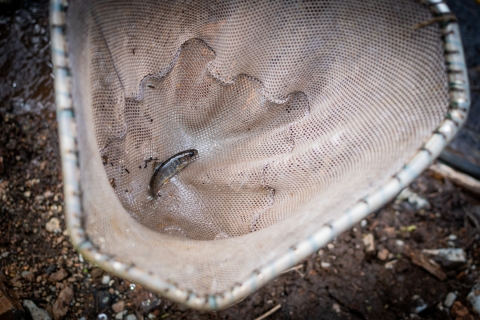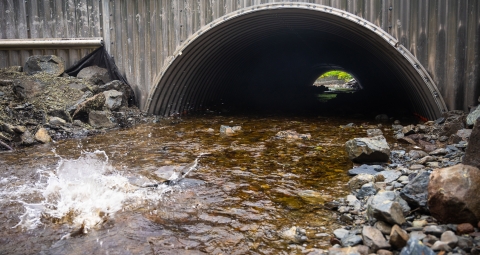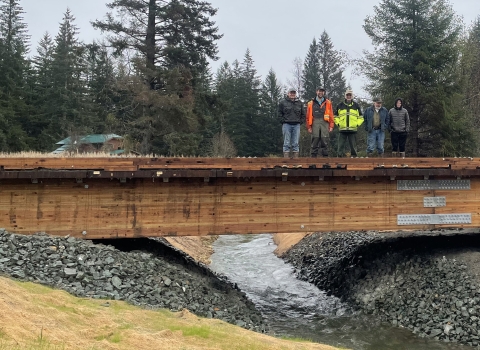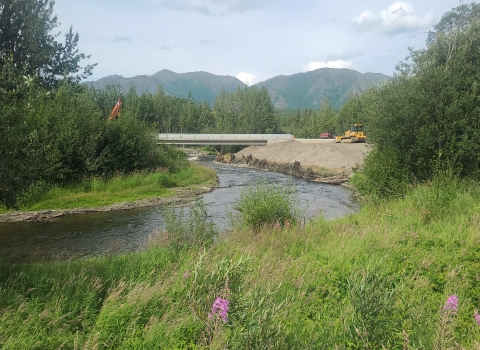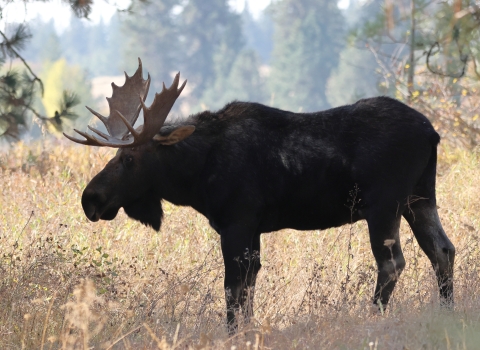Sitka, Alaska — Peterson Creek is a classic Alaska creek: it’s where new generations of salmon, char, and other fishes start life. Specifically, Peterson Creek happens to be home to Coho Salmon, Pink Salmon and Dolly Varden char.
This fish passage fish passage
Fish passage is the ability of fish or other aquatic species to move freely throughout their life to find food, reproduce, and complete their natural migration cycles. Millions of barriers to fish passage across the country are fragmenting habitat and leading to species declines. The U.S. Fish and Wildlife Service's National Fish Passage Program is working to reconnect watersheds to benefit both wildlife and people.
Learn more about fish passage project was completed just in time for salmon returning to spawn and Sitka’s youth returning to school.
Culverts placed where roads cross streams can pose barriers to fish if not designed with fish behavior and flow in mind: they’re often undersized in relation to the creek’s width, and placed atop (instead of embedded in) the streambed. This makes it difficult for fish — especially juveniles that aren’t strong swimmers yet — to move up or downstream through the crossing. Peterson Creek had two such culverts.
“If there’s one thing that Alaskans can rally around, it’s salmon. These projects are a win-win for both salmon and infrastructure stability in communities.” — Andy Stevens, Fish Biologist, U.S. Fish & Wildlife Service
With community support from the Sitka Economic Development Association, Sitka Chamber of Commerce, and Sitka Conservation Society, and assistance from the Alaska Sustainable Salmon Fund, the U.S. Fish and Wildlife Service, City and Borough of Sitka, and Marble Construction came together to restore fish passage where Peterson Avenue crosses Peterson Creek.
“Fully community-supported projects are the right way to do infrastructure projects when living in a salmon landscape.” — Andrew Thoms, Executive Director, Sitka Conservation Society
This new culvert is designed to accommodate not just the variable swimming abilities of fish, but also the creek’s full range of high and low flows. This kind of design also promotes the normal movement of logs, rocks, leaves and other natural materials found in and along the creek (movement of which create habitat and feeding opportunities for fish and their prey).
“Salmon need uninterrupted routes from the ocean to their spawning grounds. Roads and dams are inevitable, but have made this difficult. Incorporating affordable infrastructure like this makes it much easier for salmon to retain a greater portion of their habitat, even in developed areas.” — Dan Kirsch, Project Manager, Professional and Technical Services, Inc.
Culverts sized and placed with intention also benefit people. Where undersized round culverts placed on top of the streambed are more likely to create a plunge pool downstream and “blow out” under the force of a flood, fish-friendly arch culverts and bridges that span beyond the channel to accommodate high flows can handle flood conditions better.
That means safer routes to and from home and school, and fewer (if any) delays during a storm/flood events.
Fish are a key part of peoples’ ways of life in Sitka and all of Alaska, feeding families and forests, and sustaining communities, economies, and the entire environment.
“Finding a balance between protecting salmon habitat and supporting development in communities is important so both can continue to coexist. Salmon habitat is important to protect to maintain healthy salmon populations that support communities through food resources, jobs, and tourism…” — Jesse Lindgren, Alaska Department of Fish & Game Habitat Biologist
For Peterson Creek, one barrier remains just a few hundred feet upstream at the intersection of Wachusetts Street. To continue improving and making Sitka’s streams healthier and roads more resilient for the future, partners plan to remove this barrier too, and reconnect downstream habitat to important upstream habitat in the headwaters of Peterson Creek.
The U.S. Fish and Wildlife Service’s Fish Passage and Partners for Fish and Wildlife programs allow the flexibility to do restoration on non-federal lands. This makes working relationships with partners like the Sitka Conservation Society, municipalities like Sitka, or even private landowners a possibility.
We honor, thank, and celebrate the whole community — individuals, Tribes, the State of Alaska, sister agencies, fish enthusiasts, scientists, and others — who have elevated our understanding and love, as people and professionals, of all the fish.In Alaska we are shared stewards of world renowned natural resources and our nation’s last true wild places. Our hope is that each generation has the opportunity to live with, live from, discover and enjoy the wildness of this awe-inspiring land and the people who love and depend on it.
Subscribe to Fish of the Week! on Apple or wherever you get your podcasts




